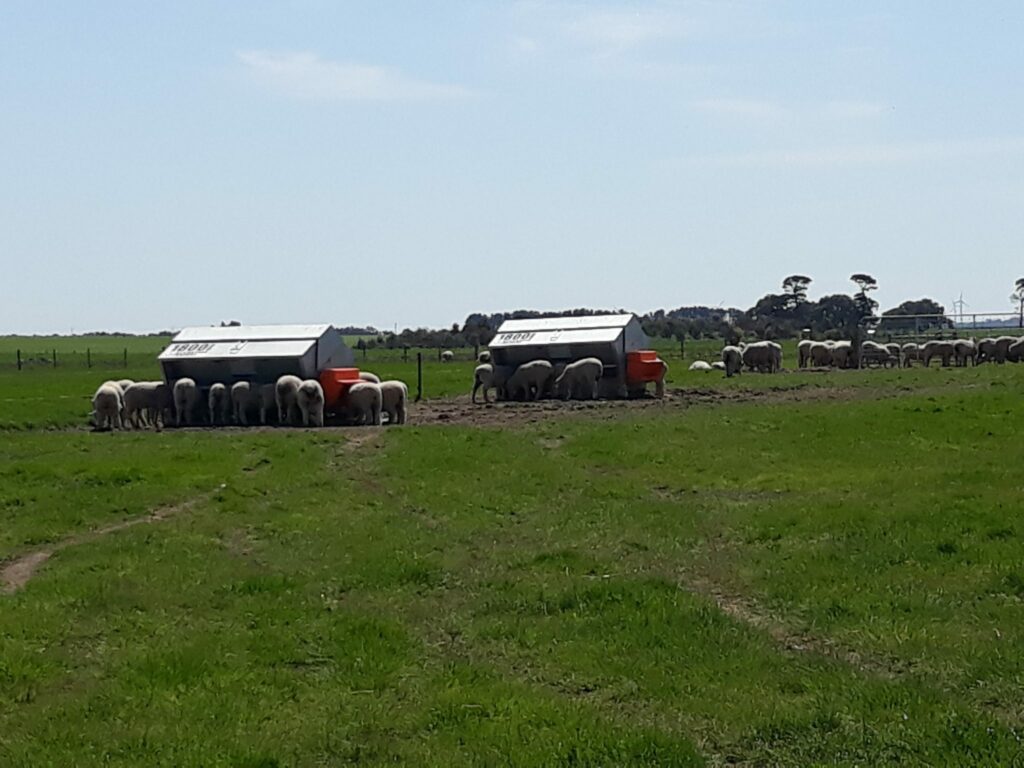Having good quality pasture is an asset to any profitable enterprise, however there are periods throughout the year, primarily Spring, when our pastures can be so good, they can actually stagnate our lamb production rates. This is due to the high amount of protein present in pasture throughout this period. Whilst protein is essential for lamb production, too much can actually restrict you reaching maximum growth rates.
The issue of excessive protein
Depending on the age and type, stock require on average 14-18% protein in their diet to maximise their growth rates. High quality pastures can have protein levels ranging between 25-35% throughout the year. These high protein levels create a protein imbalance within the animal, that can lead to waste of energy. This is because the excess protein in addition to requirements is converted to ammonia in the rumen, absorbed through the rumen wall and transported to the kidneys though the blood, where it is converted to urea and excreted out of the animal in their urine.
With the support of two leading ruminant nutritionists, it is thought that the amount of energy wasted excreting the excessive protein could be between 0.14-0.18MJ per additional percentage of protein.
To help explain this better consider the following scenario of a 35kg lamb. Daily requirement of 15.5% protein to meet growth production goals, grazing a pasture with protein of 28.9% and NDF (Neutral Detergent Fibre, i.e. the % of the pasture that has no nutritional value) of 32.5%. Assuming the energy used to excrete excess protein is 0.15MJ per additional % in protein consumed above requirement, the wasted energy is 2.6MJ/day. See calculations below.
| Lamb body weight (BW) | 35 | kg |
| NDF of pasture | 32.5 | % |
| Daily intake % | = 120 / NDF (Base equation*) | |
| = 120 / 32.5 | ||
| 3.692 | % of BW | |
| Daily intake | = BW x Daily intake % | |
| = 35 x 3.692 | ||
| 1.292 | kgDM/day | |
| Energy density of feed | 12.5 | MJ/kgDM |
| Energy intake of lamb | = Intake x Energy density | |
| = 1.292 x 12.5 | ||
| 16.2 | MJ/day | |
| Pasture protein | 28.9 | % |
| Protein requirement of 35kg lamb | 15.5 | % |
| Excess protein % | = Pasture protein % – Protein requirement % | |
| = 28.9 – 15.5 | ||
| 13.4 | % | |
| Energy to excrete 1% excess of protein | 0.15 | MJ |
| Energy to excrete excess protein from the pasture (WASTED ENERGY) | = Energy to excrete 1% of protein x Excess protein % x Daily intake | |
| = 0.15 x 13.4 x 1.292 | ||
| 2.60 | MJ/day |
How to resolve the issue of wasted energy
An extract from Penn State University webpage explains “grains and supplements that are high in readily fermentable carbohydrates need to be fed to enable rumen microbes to “capture” this protein and synthesise microbial protein.”
Feeds that are high in starch have readily fermentable carbohydrates. Types of feeds include wheat, barley triticale and high starch pellets.
The quantity of supplement feed to offer lambs has also not been researched however, from an on-farm trial that we did in New Zealand, 7.5-10% of the total daily ration appears to be effective. For the 35kg lamb in this example, this amounts to approximately 130g/day.
Additional reading from trial work done in the USA dairy industry: https://extension.psu.edu/protein-in-pastures-can-it-be-too-high
The benefits of resolving the issue of wasted energy
If further assumptions are made that the maintenance energy requirement (the amount or energy the lamb requires for no weight gain) is 7.3MJ/day, the lamb that has no mitigation (no supplementation) for the excess in protein, it would only have 6.3MJ/day of energy for growth.
However, if the excess protein is mitigated (by supplementation), the lamb would have 8.9MJ/day of energy for growth.
This lamb now has a 41.5% increase in growth rate, hits target weights faster and consumes approximately 31% less pasture (taking into account that 10% of its diet is made up of supplement). This allows for a higher stocking rate and more kg/Ha to be produced.
See calculations below.
| Maintenance energy of a 35kg lamb | 7.3 | MJ/day |
| Energy for production (NO WASTE MITIGATED) | = Energy intake – Maintenance energy – Wasted Energy through excess protein excretion (above table) | |
| = 16.2 – 7.3 – 2.6 | ||
| 6.3 | MJ/day | |
| Energy for production (WASTE MITIGATED) | = Energy intake – Maintenance energy – Wasted Energy | |
| = 16.2 – 7.3 – 0.0 | ||
| 8.9 | MJ/day | |
| Increased growth rate of WASTE MITIGATED | = (Energy for production (WASTE MITIGATED) – Energy for production (NO WASTE MITIGATED) – 1 | |
| = (8.9/6.3) – 1 | ||
| 41.5 | % |
The completed on-farm trial
Advantage Feeders conducted a trial with a farmer in the South Island of New Zealand where lambs were grazing Lucerne pastures. It showed that adding 100g/day of wheat (a good source of readily fermentable carbohydrates) into the diet increased weight gain of the lambs by 100g/day. While this trial showed a great result, the feeder group had two feeders for 800 lambs, which is overstocking the feeders, and most farmers are finishing lambs on pastures other than Lucerne.


